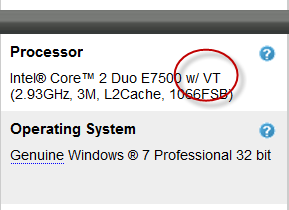Will your new Windows 7 PC support XP Mode?

Last May, a few months before Windows 7 was released to manufacturing, I looked at the then-current crop of CPUs available for business PC buyers and identified a potential sticking point: Some of the most popular Intel CPUs available at the time didn't support hardware-assisted virtualization (HAV). That made them incompatible with the newly announced Windows Virtual PC and Windows XP Mode, a crucial compatibility feature in Windows 7. (For details about Intel CPU support, see "How many Intel CPUs will fail the XP Mode test in Windows 7?" For a closer look at Windows XP Mode, see this video demo.)
The problem is that Windows Virtual PC requires hardware-assisted virtualization (Intel VT for Intel CPUs, AMD-V for AMD processors). And the late-2008/early-2009 CPU lineup from Intel was notoriously inconsistent in its support for VT.
So, is that issue still a sticking point for corporate customers considering a Windows 7 upgrade in 2010? My quick survey of the current PC market says you're much less likely to run into virtualization problems today, but at most online shopping sites you'll have a hard time finding details about virtualization support for specific models. Here's a recap:
Dell's lineup of Intel-powered business PCs specifically identifies them as being VT-capable. The budget Vostro line, for example, includes the latest versions of Intel's E5400, E7500, and Q8200. On Dell's website, the specs explicitly list VT support for all of those CPUs.

Likewise, Dell's low-end Vostro notebooks (with starting prices of $649 or less) include SU3500 and SU7300 processors, both of which include VT support. The lowest of the low-end Vostro notebooks includes a Celeron M 743 processor, which lacks VT support. But it's sold with Ubuntu Linux, not with Windows.
In the higher-end lines, Dell has the AMD-powered OptiPlex 740, which doesn't require any research. All modern AMD CPUs with the exception of the very-low-end Sempron line support hardware-assisted virtualization. The Intel-powered OptiPlex series also supports VT in all models except those powered by ancient Celeron CPUs--and those models come with Windows Vista Home Basic, not Windows 7. Dell's website makes it clear when an OptiPlex model includes VT support
Over at HP's business site, it wasn't so easy to tell whether a specific model supports VT. The lowest-end Compaq desktop machines on HP's website all include Intel Pentium processors in the E5000 and E6000 series. If you get an E6300 CPU, you're good to go, as all Intel parts with that label support VT. The E5300 is more problematic, however, because Intel redesigned it last year to add VT support. Some E5300s support HAV, others don't. Caveat emptor.
Among HP's notebooks, it was equally difficult to tell which models support HAV. The low-end Compaq models don't offer any clue in the specs. Even the HP Notebook Finder, which lists 77 different models, doesn't offer any way to filter buying choices by virtualization support.
Sony's website pointed me to VAIO Y series when I asked for business notebooks, but even though that series includes the option for Windows 7 Professional there's no mention of VT support. The specs tell me it uses an SU7300 CPU, which does indeed support VT
Likewise, Toshiba's website offers a plethora of models, but when I searched for VT and virtualization I got no results back. And in the specifications for individual models, there was no mention of those topics. A Toshiba support article entitled "Using Virtualization Technology" (PDF) sounded promising but was ultimately disappointing, offering this unhelpful text: "If your BIOS does not provide virtualization technology as an option, this feature is not supported on your computer model."
So what's a business buyer to do?
For starters, I recommend that you make HAV a checklist item on new PC purchases. At every price point, I found choices that include VT support among notebooks and desktop PCs. Unless you're absolutely certain you will never need it, this should be a must-have item.
If you're shopping with Dell, this information is easy to find, and they deserve credit for that transparency. If you can't confirm from published specs that a specific model supports virtualization from your preferred vendor, ask. Get written assurance from the PC supplier that the model you're purchasing includes support for HAV, not just in the CPU but in the BIOS.